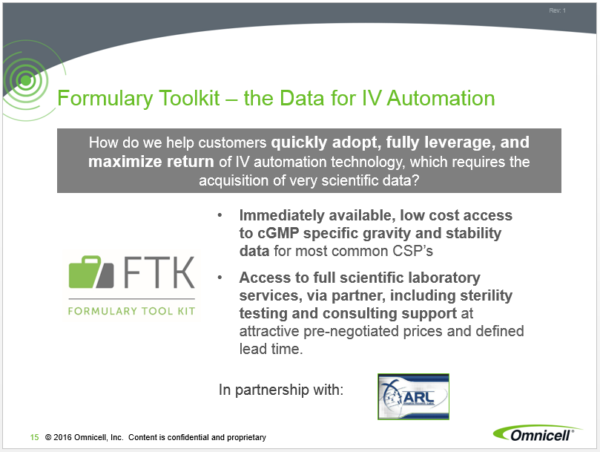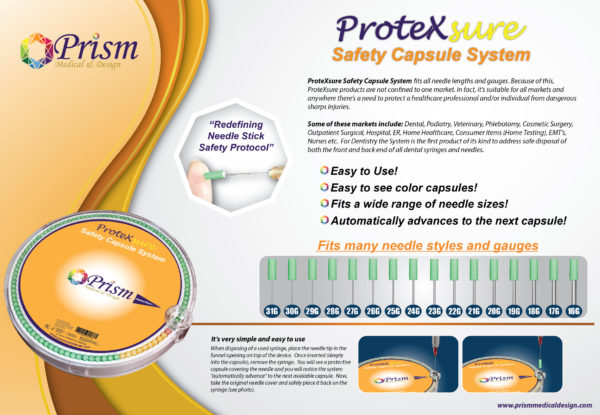There’s an interesting article in Pharmacy Practice News this month (In the IV Room, Robots Come to the Rescue). While the title of the article is a bit misleading – I think ‘rescue’ is a bit strong – it does contain quite a bit of good information.
The article discusses some of the technology being used at Brigham and Women’s Hospital (BWH) in Boston, and the University of California, San Francisco (UCSF) Mission Bay pharmacy. I’ve been in both pharmacies. BWH and UCSF both make extensive use of technology, but believe me when I say that they have very different approaches. Anyway, the article is worth a few minutes of your time.
Deep in the article, the author, Rajiv Leventhal spends a few paragraphs discussing the scope of the problem in the IV room, and some of the challenges of using robotics. Rajiv acknowledges that the iv room is a dangerous place for a host of reasons.
Regardless of the technology chosen, the need to automate IV compounding to at least some degree is hard to dispute, given the relatively high rate of errors that occur when technology is limited. In 1997, when many of the recent advances in robotics were not available, the error rate for IV compounding was 9%—or one mistake in every 11 medications coming out of the IV room.
As for the main cases [sic] of those errors, many factors have been identified, including sterility and other drug safety issues, according to a safety alert released last year by the Institute for Safe Medication Practices. The alert identified five core causes: 1) depreciating importance of the compounding and dispensing processes in pharmacy practice; 2) lack of knowledge and standardization around best practices; 3) training based on traditions handed down from one pharmacist to the next; 4) learned workplace tolerance of risk and routine practice deviations that persist; and 5) a reluctance to learn from the mistakes of others.
It seems intuitively obvious that the use of technologies like iv workflow management software, barcode scanning, gravimetrics, imaging, and even robotics can potentially decrease errors described in the article referenced above (Am J Health Syst Pharm1997;54[8]:904-912 ). However, of the causes identified in the second paragraph, only #2 can really be addressed with the use of technology alone. The rest of the items listed are symptoms of a deep-seeded problem growing in pharmacies today, and that is the failure to understand the need for our profession to provide patients with medications in the most efficient, safe, and economical way possible. Sounds ridiculous, I know, but it’s true nonetheless.
Most (all?) pharmacies I visit these days tout initiatives to improve patient care through increased ‘clinical activities’ of pharmacists, including electronic chart review, ADE follow-up, rounding with the medical team, monitoring and adjusting medications, antibiotic stewardship, and so on. However, I rarely, if ever hear directors talk about efforts to improve operations through streamlined processes, automation and technology, standardization, and heaven forbid, increased use of technicians and non-pharmacist personnel.
Examples of this can be found within open job listings at various healthcare systems. Recently I visited an acute care pharmacy with a large budget for several open ‘clinical pharmacist’s positions’ but no budget for improving operations or automating processes. In this particular case, a fraction of the money being allocated for open clinical pharmacist positions could be used to make significant improvements to the medication distribution process.
It’s an interesting dilemma for pharmacy directors. While spending tens of thousands of dollars on automation and technology to improve operations may not seem sexy, it goes without saying that a vast majority of care for a hospitalized patient involves getting the right drug at the right time. A majority of that falls to nursing staff, but the pharmacy owns a piece of the medication distribution/administration process. Nurses can’t administer medications if they’re not readily available, or wrong.
Regardless of what direction the profession wants to go, it is important that we understand that pharmacy is, at this time, tied to distribution. We must find ways to extricate ourselves from the medication distribution process first before we can begin to truly realize the benefits of pharmacists in patient care. Each time an error occurs for lack of focus, training, or sheer disinterest, the profession suffers. Preventable medication errors involving the pharmacy causes both the public and other healthcare practitioners to lose trust in our ability to get the job done. It’s difficult to recover from lack of trust. Think about it.


